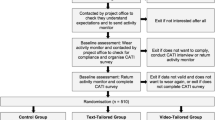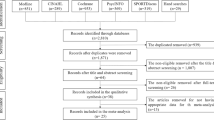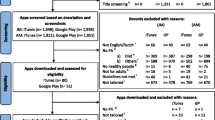Abstract
Background: Although computer-tailored promotion of dietary change and physical activity has been identified as a promising intervention strategy, there is a need for a more systematic evaluation of the evidence.Purpose: This study systematically reviews the scientific literature on computer-tailored physical activity and nutrition education.Methods: Intervention studies published from 1965 up to September 2004 were identified through a structured search in PubMed, PsycInfo, and Web of Science and an examination of reference lists of relevant publications. Studies were included that applied a pretest-post-test randomized-controlled trial design, were aimed at primary prevention among adults, used computer-tailored interventions to change physical activity and dietary behaviors, and were published in English. The search resulted in 30 publications— 11 on physical activity behaviors and 26 on nutrition behaviors, some studies investigated multiple behaviors.Results: Three of 11 of the physical activity studies and 20 of 26 of the nutrition studies found significant effects of the tailored interventions. The evidence was most consistent for tailored interventions on fat reduction.Conclusions: Overall, there seems to be potential for the application of computer tailoring for promoting healthy diets, but more research is needed to test computer-tailored interventions against other state-of-the-art intervention techniques and to identify the mechanisms underlying successful computer tailoring.
Similar content being viewed by others
References
Murray CJL, Lopez AD: Global mortality, disability, and the contribution of risk factors: Global burden of disease study.The Lancet. 1997,349:1436–1442.
Visscher TLS, Seidell JC: The public health impact of obesity.Annual Review of Public Health. 2001,22:355–375.
Glenny AM, O’Meara S, Melville A, et al.: The treatment and prevention of obesity: A systematic review of the literature.International Journal of Obesity. 1997,21:715–737.
Hooper L, Summerbell CD, Higgins JPT, et al.: Dietary fat intake and prevention of cardiovascular disease: Systematic review.British Medical Journal. 2001,322:757–763.
Ezzati M, Lopez AD, Rodgers A, et al.: Selected major risk factors and global and regional burden of disease.The Lancet. 2002,360:1347–1360.
Caspersen CJ, Pereira MA, Curran KM: Changes in physical activity patterns in the United States, by sex and cross-sectional age.Medical Science in Sports and Exercise. 2000,32:1601–1609.
Ooijendijk WTM, Hildebrandt VH, Stiggelbout M:Trendrapport Bewegen En Gezondheid 2000/2001[Report on Trends in Physical Activity and Health)]. Hoofddorp, The Netherlands: TNO Arbeid, 2002.
Pratt M, Macera CA, Blanton C: Levels of physical activity and inactivity in children and adults in the United States: Current evidence and research issues.Medical Science in Sports and Exercise. 1999,31:S526-S533.
Beer-Borst S, Hercberg S, Morabia A, et al.: Dietary patterns in six European populations: Results from euralim, a collaborative European data harmonization and information campaign.European Journal of Clinical Nutrition. 2000,54:253–262.
Ganji V, Betts N: Fat, cholesterol, fiber and sodium intakes of us population: Evaluation of diets reported in 1987-1988 nationwide food consumption survey.European Journal of Clinical Nutrition. 1995,49:915–920.
Contento IR, Randell JS, Basch CE: Review and analysis of evaluation measures used in nutrition education intervention research.Journal of Nutrition Education and Behavior. 2002,34:2–25.
Ammerman AS, Lindquist C, Hersey J, et al.:The Efficacy of Interventions to Modify Dietary Behavior Related to Cancer Risk. Chapel Hill, NC: Research Triangle Institute, 2001.
Kahn EB, Ramsey LT, Brownson RC, et al.: The effectiveness of interventions to increase physical activity; a systematic review.American Journal of Preventive Medicine. 2002,22:73–107.
Kreuter MW, Strecher VJ, Glassman B: One size does not fit all: The case for tailoring print materials.Annals of Behavioral Medicine. 1999,21:276–283.
Kreuter M, Farrell D, Olevitch L, Brennan L:Tailoring Health Messages: Customizing Communication With Computer Technology. Mahwah, NJ: Lawrence Erlbaum Associates, Inc., 2000.
Strecher VJ: Computer-tailored smoking cessation materials: a review and discussion.Patient Education and Counseling. 1999,36:101–117.
De Vries H, Brug J: Computer-tailored interventions motivating people to adopt health promoting behaviours: Introduction to a new approach.Patient Education and Counseling. 1999,36:99–105.
Lechner L, Brug J, De Vries H: Misconceptions of fruit and vegetable consumption: Differences between objective and subjective estimation of intake.Journal of Nutrition Education. 1997,29:313–320.
Ronda G, Van Assema P, Brug J: Stages of change, psychological factors and awareness of physical activity levels in The Netherlands.Health Promotion International. 2001,16:305–314.
Brug J, Oenema A, Kroeze W, Raat H: The Internet and nutrition education: Challenges and opportunities.European Journal in Clinical Nutrition. 2005,59:S130-S139.
Brug J, Oenema A, Campbell M: Past, present, and future of computer-tailored nutrition education.American Journal of Clinical Nutrition. 2003,77:1028S-1034S.
Kreuter MW, Wray RJ: Tailored and targeted health communication: Strategies for enhancing information relevance.American Journal of Health Behavior. 2003,27:S227-S232.
Skinner CS, Campbell MK, Rimer BK, et al.: How effective is tailored print communication?Annals of Behavioral Medicine. 1999,21:290–298.
Clarke M, Oxman AD (eds):Cochrane Reviewers Handbook 4.1.5. [Updated April 2002]. InThe Cochrane Library, issue 2. Oxford, UK: Update Software. 2002.
Contento I, Balch GI, Bronner YL, et al.: The effectiveness of nutrition education and implications for nutrition education policy, programs and research: A review of research.Journal of Nutrition Education. 1995,27:277–422.
Cohen J:Statistical Power Analysis for the Behavioural Sciences. New York: Academic, 1977.
Dolan Mullen P, Simons-Morton DG, Ramérez G, et al.: A meta-analysis of trials evaluating patient education and counseling for three groups of preventive health behaviors.Patient Education and Counseling. 1997,32:157–173.
Bock BC, Marcus BH, Pinto BM, Forsyth LH: Maintenance of physical activity following an individualized motivationally tailored intervention.Annals of Behavioral Medicine. 2001,23:79–87.
Marcus BH, Bock BC, Pinto BM, et al.: Efficacy of an individualized, motivationally-tailored physical activity intervention.Annals of Behavioral Medicine. 1998,20:174–180.
Kreuter MW, Oswald DL, Bull FC, Clark EM: Aretailoredhealth education materials always move effective than non-tailored materials?Health Education Research. 2000,15:305–315.
Bull FC, Holt CL, Kreuter MW, et al.: Understanding the effects of printed health education materials: Which features lead to which outcomes?Journal of Health Communication. 2001,6:265–279.
Blalock SJ, DeVellis BM, Patterson CC, et al.: Effects of an osteoporosis prevention program incorporating tailored educational materials.American Journal of Health Promotion. 2002,16:146–156.
Campbell MK, James A, Hudson MA, et al.: Improving multiple behaviours for colorectal cancer prevention among African American church members.Health Psychology. 2004,23:492–502.
Kreuter MW, Strecher VJ: Do tailored behavior change messages enhance the effectiveness of health risk appraisal? Results from a randomized trial.Health Education Research. 1996,11:97–105.
Vandelanotte C, De Bourdeaudhuij I, Sallis JF, et al.: Efficacy of sequential or simultaneous interactive computer-tailored interventions for increasing physical activity and decreasing fat intake.Annals of Behavioral Medicine. 2005,29:138–146.
Wylie-Rosett J, Swencionis C, Ginsberg M, et al.:Computerized weight loss intervention optimizes staff time: The clinical and cost results of a controlled clinical trial conducted in a managed care setting.Journal of the American Dietetic Association. 2001,101:1155–1162; quiz 1163-1154.
Bull FC, Jamrozik K, Blanksby BA: Tailored advice on exercise: Does it make a difference?American Journal of Preventive Medicine. 1999,16:230–239.
Bull FC, Kreuter MW, Scharff DP: Effects of tailored, personalized and general health messages on physical activity.Patient Education and Counseling. 1999,36:181–192.
Anderson ES, Winett RA, Wojcik JR, et al.: A computerized social cognitive intervention for nutrition behavior: Direct and mediated effects on fat, fiber, fruits, and vegetables, self-efficacy, and outcome expectations among food shoppers.Annals of Behavioral Medicine. 2001,23:88–100.
Brug J, Steenhuis I, Van Assema P, De Vries H: The impact of a computer-tailored nutrition intervention.Preventive Medicine. 1996,25:236–242.
Brug J, Glanz K, Van Assema P, et al.: The impact of computer-tailored feedback and iterative feedback on fat, fruit, and vegetable intake.Health Education and Behavior. 1998,25:517–531.
Campbell MK, DeVellis BM, Strecher VJ, et al.: Improving dietary behavior: The effectiveness of tailored messages in primary care settings.American Journal of Public Health. 1994,84:783–787.
Campbell MK, Bernhardt JM, Waldmiller M, et al.: Varying the message source in computer-tailored nutrition education.Patient Education and Counseling. 1999,36:157–169.
Campbell MK, Carbone E, Honess-Morreale L, et al.: Randomized trial of a tailored nutrition education CD-ROM program for women receiving food assistance.Journal of Nutrition Education and Behavior. 2004,36:58–66.
De Bourdeaudhuij I, Brug J: Tailoring dietary feedback to reduce fat intake: An intervention at the family level.Health Education Research. 2000,15:449–462.
Greene GW, Rossi, SR: Stages of change for reducing dietary fat intake over 18 months.Journal of the American Dietetic Association. 1998,98:529–534.
Irvine AB, Ary DV, Grove DA, Gilfillan-Morton L: The effectiveness of an interactive multimedia program to influence eating habits.Health Education Research. 2004,19:290–305.
Raats MM, Sparks P, Geekie MA, Shepherd R: The effects of providing personalized dietary feedback. A semi-computerized approach.Patient Education and Counseling. 1999,37:177–189.
Winett RA, Kramer KD, Walker WB, et al.: Modifying food purchases in supermarkets with modeling, feedback, and goal-setting procedures.Journal of Applied Behavior Analysis. 1988,21:73–80.
Winett RA, Moore JF, Wagner JL, et al.: Altering shoppers’ supermarket purchases to fit nutritional guidelines: An interactive information system.Journal of Applied Behavior Analysis. 1991,24:95–105.
Winett RA, Wagner JL, Moore JF, et al.: An experimental evaluation of a prototype public access nutrition information system for supermarkets.Health Psychology. 1991,10:75–78.
Winett RA, Anderson ES, Bickely PG, et al.: Nutrition for a lifetime system: A multimedia system for altering food supermarket shoppers’ purchases to meet nutritional guidelines.Computers in Human Behavior. 1997,13:371–392.
Baker AH, Wardle J: Increasing fruit and vegetable intake among adults attending colorectal cancer screening: The efficacy of a brief tailored intervention.Cancer Epidemiology, Biomarkers & Prevention. 2002,11:203–206.
Lutz SF, Ammerman AS, Atwood JR, et al.: Innovative newsletter interventions improve fruit and vegetable consumption in healthy adults.Journal of the American Dietetic Association. 1999,99:705–709.
Oenema A, Tan F, Brug J: Short-term impact of a Web-based tailored nutrition intervention; main effects and mediators.Annals of Behavioral Medicine. 2005,29:54–63.
Brinberg D: Changing food knowledge, food choice, and dietary fiber consumption by using tailored messages.Appetite. 2000,35:35–43.
Prochaska JO, Velicer WF: The transtheoretical model of health behavior change.American Journal of Health Promotion. 1997,38:38–48.
Bandura A:Social Foundations of Thought and Action: A Social Cognitive Theory. Englewood Cliffs, NJ: Prentice Hall, 1986. 213
Ajzen I: The theory of planned behavior.Organizational Behavior and Human Decision Processes. 1991,50:179–211.
Campbell MK, Honess-Morreale L, Farrell D, et al.: A tailored multimedia nutrition education pilot program for low-income women receiving food assistance.Health Education Research. 1999,14:257–267.
Block G, Hartman AM, Dresser CM, et al.: A data-based approach to diet questionnaire design and testing.American Journal of Epidemiology. 1986,124:453–469.
Van Assema P, Brug J, Kok G, Brants H: The reliability and validity of a Dutch questionnaire on fat consumption as a means to rank subjects according to individual fat intake.European Journal of Cancer Prevention. 1992,1:375–380.
Van Assema P, Brug J, Ronda G, Steenhuis I: The relative validity of a short Dutch questionnaire as a means to categorize adults and adolescents to total and saturated fat intake.Journal of Human Nutrition and Dietetics. 2001,14:377–390.
Feunekes GIJ, Van Staveren WA, De Vries JHM, et al.: Relative and biomarker-based validity of a food-frequency questionnaire estimating intake of fats and cholesterol.American Journal of Clinical Nutrition. 1993,58:489–496.
Vandelanotte C, Matthys C, De Bourdeaudhuij I: Reliability and validity of a computerised questionnaire to measure fat intake in Belgium.Nutrition Research. 2004,24:621–631.
Van Assema P, Brug J, Ronda G, et al.: A short Dutch questionnaire to measure fruit and vegetable intake: Relative validity among adults and adolescents.Nutrition and Health. 2002,16:85–106.
Bogers RP, Van Assema P, Kester AD, et al.: Reproducibility, validity, and responsiveness to change of a short questionnaire for measuring fruit and vegetable intake.American Journal of Epidemiology. 2004,159:900–909.
Van Rooyen S, Godlee F, Evans S, et al.: Effect of blinding and unmasking on the quality of peer review.Journal of the American Medical Association. 1998,280:234–237.
Davidoff F: Masking, blinding, and peer review.Annals of Internal Medicine. 1998,128:66–68.
Brug J, Campbell M, van Assema P: The application and impact of computer-generated personalized nutrition education: A review of the literature.Patient Education and Counseling. 1999,36:145–156.
Baranowski T, Weber Cullen K, Baranowski J: Psychosocial correlates of dietary intake: Advancing dietary intervention.Annual Review of Nutrition. 1999,19:17–40.
McGuire WJ: Attitudes and attitude change. In Lindzey G, Aronson E (eds),The Handbook of Social Psychology (3rd Ed.). New York: Random House, 1985, 233–346.
Vanhees L, Lefevre J, Philippaerts R, et al.: How to assess physical activity? How to assess physical fitness?European Journal of Cardiovascular Prevention and Rehabilitation. 2005,12:102–114.
Van ’tVeer P, Kardinaal AFM, Bausch-Goldbohm RA, Kok FJ: Biomarkers for validation.European Journal of Clinical Nutrition. 1993,47:S58-S63.
Green LW, Kreuter MW:Health Promotion Planning: An Educational and Environmental Approach. Mayfield, CA: Mountain View, 1999.
Bartholomew LK, Parcel GS, Kok G, Gottlieb NH:Intervention Mapping; Designing Theory— and Evidence-Based Health Promotion Programs. New York: McGraw-Hill Higher Education, 2001.
Brug J, Oenema A, Ferreira I: Theory, evidence and intervention mapping to improve behavior nutrition and physical activity in interventions.International Journal of Behavioral Nutrition and Physical Activity. 2005,2:X.
Adams J, White M: Why don’t stage-based activity promotion interventions work?Health Education Research. 2005,20:237–243.
De Vet E, De Nooijer J, De Vries NK, Brug J: Determinants of forward stage transition from precontemplation and contemplation for fruit consumption.American Journal of Health Promotion. 2005,19:278–285.
Brug J, Conner M, Harre N, et al.: The transtheoretical model and stages of change: A critique: Observations by five commentators on the paper by Adams, J. and White, M. (2004) Why don’t stage-based activity promotion interventions work?Health Education Research. 2005,20:244–258.
Kreuter MW, Bull FC, Clark EM, Oswald DL: Understanding how people process health information: A comparison of tailored and nontailored weight-loss materials.Health Psychology. 1999,18:487–494.
De Bourdeaudhuij I, Brug J, Vandelanotte C, Van Oost P: Differences in impact between a family— versus an individual-based tailored intervention to reduce fat intake.Health Education Research. 2002,17:435–449.
Brug J, Steenhuis I, van Assema P, et al.: Computer-tailored nutrition education: Differences between two interventions.Health Education Research. 1999,14:249–256.
Oenema A, Brug J: Feedback strategies to raise awareness of personal dietary intake: Results of a randomized controlled trial.Preventive Medicine. 2003,36:429–439.
Skinner CS, Strecher VJ, Hospers HJ: Physicians’ recommendations for mammography: Do tailored messages make a difference?American Journal of Public Health. 1994,84:43–49.
Campbell MK, Fitzpatrick R, Haines A, et al.: Framework for design and evaluation of complex interventions to improve health.British Medical Journal. 2000,16:694–696.
Davidson KW, Goldstein M, Kaplan RM, et al.: Evidence-based behavioral medicine: What is it and how do we achieveAnnals of Behavioral Medicine. 2003,26:161–171.
Marshall AL, Owen N, Bauman AE: Mediated approaches for influencing physical activity: Update of the evidence on mass media, print, telephone and Website delivery of interventions.Journal of Science and Medicine in Sport. 2004,7:s74-s80.
Owen N, Fotheringham MJ, Marcus BH: Communication technology and health behavior change. In Glanz K, Rimer BK, Lewis FM (eds),Health Behavior and Health Education — Theory, Research and Practice. 3rd ed. San Francisco: Jossey- Bass, 2002, 510–529.
Rose G: Sick individuals and sick populations.International Journal of Epidemiology. 1985,14:32–38.
Sallis JF, Haskell WL, Wood P, et al.: Physical activity assessment methodology in the five-city project.American Journal of Epidemiology. 1985,121:91–106.
Craig CL, Marshall AR, Sjostrom M, et al.: International physical activity questionnaire: 12 -country reliability and validity.Medicine and Science in Sports and Exercise. 2003,35:1381–1395.
Paffenbarger RS, Wing AL, Hyde RT: Physical activity as an index of heart attack risk in college alumni.American Journal of Epidemiology. 1978,108:161–175.
Systems BDD:Block 95 Food Frequency Questionnaire. Berkley, CA: Block Dietary Data Systems, 1995.
Block G, Clifford C, Naughton MD, et al.:A brief dietary screen for high fat intake.Journal of Nutrition Education. 1989,21:199–207. 214
Block G, Gillespie C, Rosenbaum EH, Jenson C: A rapid food screener to assess fat and fruit and vegetable intake.American Journal of Preventive Medicine. 2000,18:284–288.
Kristal AR, Shattuck AL, Henry HJ, Fowler AS: Rapid assessment of dietary intake of fat, fiber, and saturated fat: Validity of an instrument suitable for community intervention research and nutritional surveillance.American Journal of Health Promotion. 1990,4:288–295.
Kristal AR, White E, Shattuck AL, et al.:Long-term maintenance of a low-fat diet: Durability of fat related dietary habits in the woman’s health trial.Journal of the American Dietetic Association. 1992,92:553–559.
Rankin JW, Anderson ES, Winett RA, et al. : Nutritional outcomes and program implications of a multimedia supermarket intervention. Unpublished manuscript, Department of Psychology, Virginia Tech: 1996.
Roe L, Strong C, Whiteside C, et al.: Dietary intervention in primary care: Validity of the dine method for diet assessment.Family Practice. 1994,11:375–381.
Brug J, Lechner L, De Vries H: Psychosocial determinants of fruit and vegetable consumption.Appetite. 1995,25:285–296.
McClelland J, Demark W, Mustian D, et al.: Fruit and vegetable consumption of rural African Americans: Baseline survey results of the black churches united for better health 5-a-day project.Nutrition and Cancer. 1998,30:148–157.
Subar AF, Heimendinger J, Patterson BH, et al.: Fruit and vegetable intake in the United States: The baseline survey of the five a day for better health program.American Journal of Health Promotion. 1995,9:352–360.
Guthrie JF: Psychosocial determinants of consumption of fiber-rich foods. Unpublished doctoral dissertation, University of Maryland-College Park: 1988.
McGuire WJ (ed):Theoretical Foundations of Campaigns. Newbury Park, CA: Sage, 1989.
Author information
Authors and Affiliations
Corresponding author
Additional information
The contribution of Willemieke Kroeze was made possible by a grant from ZonMW, The Netherlands Organization for Health Research and Development. The contribution of Andrea Werkman was made possible by a grant from the Netherlands Heart Foundation (2000T005).
About this article
Cite this article
Kroeze, W., Werkman, A. & Brug, J. A systematic review of randomized trials on the effectiveness of computer-tailored education on physical activity and dietary behaviors. ann. behav. med. 31, 205–223 (2006). https://doi.org/10.1207/s15324796abm3103_2
Issue Date:
DOI: https://doi.org/10.1207/s15324796abm3103_2




